The Checker Maven
The Long Road Home

It's Thanksgiving Weekend in the United States, a very special and very American holiday, and a weekend on which many people travel long distances to be home with family. Whether you've been able to stay close by, or have yourself journeyed on that long road home, The Checker Maven wishes you the all best of this, our favorite holiday by any measure.
For Thanksgiving Weekend, we bring you a special installment of Checker School with an instructive pair of situations from Ben Boland's classic reference, Famous Positions in the Game of Checkers. Here's the first one, and it illustrates today's theme of traveling far to reach your goal:
WHITE
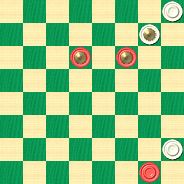
BLACK
Black to Play and Win
B:W29,K25,5:BK23,K22,1.
Black can win this position, just barely, but it requires a lot of clever maneuvering and a good dose of patience. Are you methodical enough to work it out? Can you visualize far enough ahead to find the solution without moving pieces on a board? It's quite a challenge, and indeed a long road home.
Here is a much easier one, which arises from a variant of the tougher one above:
WHITE

BLACK
Black to Play and Win
B:W17,5:BK10,1.
The solution is very neat and not all that difficult to find. Can you do it?
Whether you in fact find your way, or remain lost, clicking on Read More will guide you on the path to Ben Boland's solution, descriptive notes, example games, and entertaining comments.![]()
The Captured Bear

Brian Hinkle's ferocious bear is finally captured in today's Checker Maven column.
No, we did not receive any correct solutions. We did receive some pretty good attempts; and we also heard from a few skeptics who claimed the setting was wrong to begin with.
So, at long last, we present Brian's solution to what we believe is destined to become an enduring, classic problem--- a great new variation on a theme which, strangely enough, has been around for quite a number of years.
To refresh your memory, here's the situation:
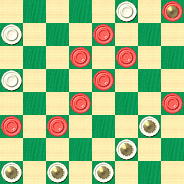
BLACK
Black to Play and Draw
B:W30,28,20,K9,K6,K4,K3,K2:BK29,26,23,22,18,15,13,12,11.
| 1. | 11-16 |
Alternatively, Black can first play 22-25, 30-21, 18-22 and the results are almost the same.
| 1. | ... | 20x11 |
| 2. | 22-25 |
This is the second, necessary pitch, that removes the "clutter."
| 2. | ... | 30x21 |
| 3. | 18-22 |
Moving to start the formation of a 4-piece "clover leaf of safety."
| 3. | ... | 28-24 |
If ... 6-10 then black can immediately complete the "clover leaf of safety" with 15-18 and white cannot penetrate the position, for instance 10-15 12-16 15-19 16-20 19-15 29-25 15-19 and then the black man can simply stay on square 20, or black can play 20-24 and we are headed back toward the final position as played out in the main line, which continues below
The main line move as given (28-24) instead sets a trap for black.
| 4. | 12-16 |
Moving the piece farthest from the king row, and at this point the only move that draws. If black instead rushes to complete the "clover leaf of safety" with 15-18 then 24-19! and white wins as now the man on 12 cannot advance.
| 4. | ... | 4-8 |
| 5. | 15-18 |
This now completes the aforementioned 4-piece "clover leaf of safety."
| 5. | ... | 24-20 |
| 6. | 16-19 | 6-10 |
| 7. | 19-24 | 8-12 |
| 8. | 24-27 | 11-8 |
| 9. | 27-32 |
This black king will stay permanently on square 32 and complete the defensive barricade on the double corner side.
| 9. | ... | 8-4 |
| 10. | 29-25 |
And this is the king that will "wiggle forever."
| 10. | ... | 4-8 |
| 11. | 25-30 | 8-11 |
| 12. | 30-25 | 21-17 |
| 13. | 25-29 | 17-14 |
| 14. | 13-17 | 9-13 |
| 15. | 17-21 |
Drawn.
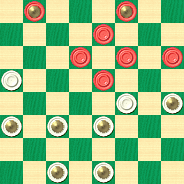
BLACK
This is now the draw formation attributed to Dr. T. J. Brown in Ben Boland's Masterpieces in the Game of Checkers, p. 155, diagram C.
Note that all seven black pieces are required and must be in position to obtain the draw.
- Four men form the "clover leaf of safety" which cannot be attacked due to
- the black king parked on square 32 (which itself cannot be drawn away), and
- the unassailable black man on 21, protecting against white incursions into the single corner, while
- the king in the single corner "wiggles" forever, watching white's futile efforts play themselves out.
It is amusing that white can move a king or kings onto squares 19, 24, 27, 28, and 31 without any effect whatsoever! Black simply ignores these efforts and continues to "wiggle" his single-corner king among squares 30, 25, and 29.
The "Bear Claw" is surely a unique and brilliant problem that will entertain checker fans for generations to come.


"The Clover Leaf Of Safety" and "The King That Wiggles Forever"
![]()
A Cross Loss

Are you cross when you find yourself in a loss?
Today's installment from our ongoing republication of Willie Ryan's unmatched Tricks Traps & Shots of the Checkerboard deals not with crossness, but with the Cross opening (more accurately, the Cresent Cross), and a neat trap that, should you fall into it, might indeed lead to a cross disposition. But you can avoid this terrible fate by studying this example and paying attention to Willie as he explains as only he can do.
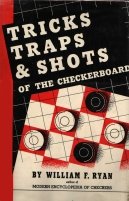
An Interesting Cross Loss
"The 26-23 line of the cross (4th move) has never enjoyed the same popularity among top-notchers as that of the 27-23 build-up. I am among the few moderns who are partial to it. The play presented on the next page reveals the one trap I have used most frequently with the white pieces:
11-15, 23-18, 8-11, 26-23, 10-14---A, 30-26, 7-10---C, 24-19, 15-24, 28-19, 11-16, 22-17, 4-8, 26-22, 9-13---D, 18-9, 5-14, forming the diagram.
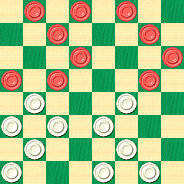
WHITE
White to Play and Win
W:W17,19,21,22,23,25,27,29,31,32:B1,2,3,6,8,10,12,13,14,16.
A---If 4-8 is used, then proceed with 30-26, 10-14, 24-19, 15-24; at this point, 27-20* is still essential, as 28-19 loses by 11-16, 32-28---B, 6-10, 22-17 (27-24, 8-11; now 22-17 is beaten by 11-15, and 24-20 by 10-15), 8-11, 26-22 (if 17-13, 10-15 wins), 1-6, 17-13, 14-17, 21-14, 10-26, 31-22, 7-10, 25-21, 16-20, 29-25, 3-7, 22-17, 9-14, 18-9, 5-14, 19-15, 11-18, 23-19, 7-11, and black wins. Wm. F. Ryan vs. H. L. Rudolph.
B---22-17, 8-11, 17-10, 6-24, 27-20, 9-14, 18-9, 5-14, 25-22, 16-19, 23-16, 12-19, 22-17, 7-10, 29-25, 3-8, 17-13, 8-12, 25-22, 11-15, 22-17, 14-18, 17-14, 10-17, 21-14, 18-23, 26-22, 23-26, 14-10, 26-30, and black wins. Wm. F. Ryan.
C---If 6-10, 24-19, 15-24, then 27-20* is correct to draw; but 28-19 loses by 11-16, 18-15 (22-17 loses immediately by 10-15), 1-6, 15-11, 14-18 *, 22-15, 9-14, 26-22, 14-18, 23-14, 16-23, 27-18, 10-26, 31-22, 7-16, 21-17, 3-7, 25-21, 16-19, 32-27, 7-10, 15-11, 2-7, etc., and black wins. Wm. F. Ryan. This win corrects draw play by Hugh McKean, W. D. Benstead, and others.
D---Tempting, but fatal. The correct play is 16-20, 17-13, 8-11, 22-17, 12-16*, 19-12, 10-15, 17-10, 15-22, 25-18, 6-22, 13-6, 1-10, 21-17, 5-9, 23-18, 9-13, 32-28, 11-16, 27-23, 2-7, 18-14, 10-15, 23-18, etc., resulting in a draw. Wm. F. Ryan."
Don't be cross yourself if you have trouble finding the solution; click on Read More to see how Willie does it.![]()
Roybn's Fast Shots

This month's speed problems were contributed by a GoldToken player who calls himself Robyn Hode. Though we're not informed about his archery skills, he's certainly a fine checkerist, as these "fast shots" will show. They are relatively easy, so we won't give you much time to fire your bolt. The first problem arises from a common beginner's blunder in the Single Corner opening. The second problem is adapted from Italian checkers.
November Speed Problem 1. 5 seconds; very easy.
November Speed Problem 2. 15 seconds; fairly easy.
Quickly find the target, but there's no need to quiver; clicking on Read More takes you straight as an arrow to the solutions.![]()
